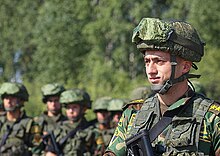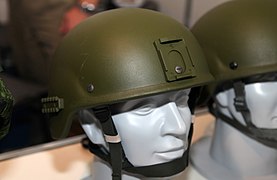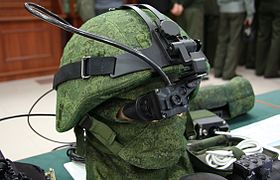Ratnik (program)
| Ratnik | |
|---|---|
 Ratnik equipment shown in Open Day 2017 with the 4th Guards Tank Division with a paratrooper (left) and recon (right) variants. | |
| Type | Future Soldier Program |
| Place of origin | |
| Service history | |
| Used by | See Users |
| Wars | Annexation of Crimea by the Russian Federation Syrian civil war |
| Production history | |
| Designer | TsNIITochMash |
| Designed | 2013-Present |
| Manufacturer | TsNIITochMash |
| Produced | 2013-Present |
| References | |
Ratnik (Russian: Ратник; Warrior) is a Russian future infantry combat system. It is designed to improve the connectivity and combat effectiveness of combat personnel in the Russian Armed Forces. Improvements include modernised body armour, a helmet with a special eye monitor (thermal, night vision monocular, flashlight), communication systems, and special headphones. It includes 10 subsystems and 59 individual items. As of October 2016, it has already seen combat use.[1][2]

History[]
The Ratnik was first to be reported to be used during the Annexation of Crimea by the Russian Federation in 2014.[3] There were also reports that Russian troops have tested Ratnik components in combat operations.[4][5]
In August 2019, it was reported that Ratnik has been tested by soldiers from Belarus, Vietnam, Kyrgyzstan, China, Laos, Mongolia, Pakistan and Uzbekistan.[6]
In July 2021, Russian troops deployed to Tajikistan to work alongside Tajik forces are equipped with at least 200 sets of Ratnik.[7]
Components[]
The Ratnik gear is a system of modern protective and communication devices, weapons and ammunition. It consists of a helmet, body armour; a one-piece coverall; hearing protection; protective glasses; a protective set for knees and elbows; a grenade launcher, submachine gun or assault rifle; sniper rifle, ammunition; a combat knife, as well as 24/7 reconnaissance means; a day and night sighting system; a small-size binocular; optical and thermal weapon sights, etc. As well as these, the system comprises a universal shelter, a multifunctional knife, a signal lamp, a watch, winter and summer two-side camouflage sets; an autonomous heat source; a backpack, an individual water filter; a small entrenching tool, breath protection devices; means of radiological and chemical control; a medical kit, and filtering clothes.[8]
The "Strelets" ("Musketeer") system provides voice and video communication. The system also includes a GLONASS navigation module so that a squad leader can see the location of each soldier on his small, book-sized, computer. With this computer, he also can give orders to his squad, and send videos and photos to headquarters. As well as this, each soldier has their own smaller telephone-sized tactical computer. The Strelets command, control, and intelligence (C2I) system was operated in the Syrian conflict to send target data to strike aircraft. The use of the Strelets in conjunction with the Su-24M frontline bomber provides almost 100% accuracy.[9]
Ratnik protects almost 90% of a soldier's body. The main body armour with plates, designated 6B45 '6Б45', is rated at protection class 6, according to GOST R 50744-95,[10] and weighs 7.5 kg (with the Assault variant weighing up to 15 kg). The main body armour fully protects from 7.62×39mm rounds from assault rifles, and 7.62×54mmR from sniper rifles, including the increased penetration of hardened rounds, and can survive hits from repeated shots in these calibres conducted at close range.[11] The plates inside the vest, designated Granit 'гранит', are removable from the 6B45 (6Б45), with the inside of the vest being lined with kevlar for additional protection. These plates are shaped similarly to the "Shooter" variant of the United States Armed Forces Small Arms Protective Insert. The 6B43 was an early iteration of the 6B45 that was initially produced as part of the Ratnik program which had removable kevlar inserts.
Variants of the Ratnik Program body armour were designed for different purposes including the 6B46 (6Б46) - a lighter-weight, para-droppable design aimed at replicating the popular small form factors and utility of the 6B48 (6Б48) - created for tank crews and issued in 2016.[12] Although the 6B46 (6Б46) was issued as part of the initial Ratnik program, there is not much evidence of them being used by units in the field, with the first mass use seen in public occurring during the Slavic Brotherhood 2019 joint international exercise in Serbia.[13]
The weight of the full Ratnik infantry system with the special thigh and shoulder bulletproof shields is 19–20 kg. Basic Ratnik gear (for engineers and medics) weighs 15 kg (without thigh and shoulder guards). Ratnik gear is made of a special fabric that prevents troops from being detected by infrared devices.[14]
Russia’s TsNIITochMash (part of the Rostec defence conglomerate) has developed more powerful 7N39 ‘Igolnik’ 5.45×39mm cartridge and its 7N40 variant, with an increased density of fire and bullet penetration during its work on the Ratnik soldier gear.[15] Russia’s holding company Shvabe has developed a new, lighter version of the thermal night vision weapon sight, which is to complement the soldier’s field combat gear Ratnik. Russia’s holding company Shvabe also created the technology increasing aiming distance.[16]
Production history[]
Prototype Ratnik kits were initially distributed to selected units in the Ground Forces in 2013 according to Oleg Martyanov, a member of Russia's Military-Industrial Commission, which acts as the government's liaison with the defense industry.[17] Initially only elite troops will receive the AK-12 as part of the Ratnik system, while the rest of the Ground Forces will continue using the AK-74M into the 2020s.[18]
For the Russian Navy and Engineer Troops, the bulletproof vest is combined with a life vest, so that soldiers and sailors who are thrown into the water won't drown. All Naval Infantry units were equipped with Ratnik gear as of November 2016.[19][20]
Serial deliveries and batch production of Ratnik began in the first half of 2015.[21] About 300,000 Ratnik sets have been delivered as of December 2020.[22] Russia’s Ground Forces and the Navy’s coastal brigades are practically fully equipped with the Ratnik combat gear in March 2019.[23] 18,000 sets delivered in 2019 in basic, commander, sniper, machine-gunner, gunner and tank man versions and 18,000 more in 2020.[24][25][26] A new version for mountainous-desert terrain begun to be delivered in July 2021.[27]
List of Individual Components in Use With The Ratnik Program[]
Combat Uniform Items[]
- VKBO Layer system - a multilayer system manufactured by BTK Group designed for use at temperatures from +15 °C (59 °F) to −40 °C (−40 °F).
- 6Sh122 Masking Suit (6ш122) - a reversible combat oversuit designed for concealment in a variety of environments
Combat Equipment[]
- 6B45/6B43 (6Б45/6Б43) - Primary body armour system for infantry units
- 6B46 (6Б46) - Plate carrier style armour system for light-weight units
- 6B48 (6Б48) Ratnik-ZK - Primary body armour system for tank and AFV crews[28]
- 6B47 (6Б47) - Aramid fibre helmet system rated for small arms fire. Includes two covers that allow the helmet to be jumpable, one white and one in the standard EMR (Digital Flora) pattern.
- 6Sh116/6Sh117 (6ш116/6ш117) - Load bearing equipment with a variety of utility and magazine pouches to suit the various weapons of the Russian Military, includes a 7-litre 'butt pack' and 25-litre patrol backpack.
- 6Sh118 RAID Pack (6ш118) - 60-litre backpack designed for carrying large equipment and for long deployments.
- GSSh-01-01 (6m2-1) - Active hearing protection with radio cable.
Accessories[]
- 6B50 (6Б50) - Dust and impact goggles
- 6B51 (6Б51) - Knee and elbow protection based on an improved version of the Russian-made Splav 'X Pads'
- 6Sh122 Gloves (6ш122)
- VKBO Summer boots
- Faradei Winterised boots
- 6E5 Light Shovel
- 6E6 Multitool
- 6Sh120 Shelter system
- 6E4-1 Watch
- FSS-014 Light - light system that can be mounted to 6B47 (6Б47) helmet
- NF-10 Individual water system
- 1PN140 and 1PN141 night and thermal vision sights[29]
Users[]
 Russia[30]
Russia[30] Serbia: Reported to be used by Serbian special forces as of 2015.[3]
Serbia: Reported to be used by Serbian special forces as of 2015.[3] Egypt[citation needed]
Egypt[citation needed] Syria[citation needed]
Syria[citation needed] China[citation needed]
China[citation needed]
Gallery[]

6B45 ballistic vest.

6B46 tactical vest.

6B47 military helmet.

6Sh117 all-purpose lightweight individual carrying equipment.

1PN139 thermographic monitor.

NPI-2 wearable GLONASS receiver for the soldier.

'Sagittarius' commanding officer tablet computer.
References[]
- ^ "Очки экипировки "Ратник" защитят от осколков, летящих со скоростью 350 м/с | Еженедельник "Военно-промышленный курьер"". vpk-news.ru. Archived from the original on October 12, 2016.
- ^ "Russia's 'soldier of future' combat gear proves its worth in Syria". Archived from the original on 2017-08-25. Retrieved 2017-08-24.
- ^ Jump up to: a b "Ratnik: Modern Problems Require Modern Solutions". 6 August 2021.
- ^ https://www.mitre.org/sites/default/files/publications/pr-19-3483-russian-lessons-learned-in-syria.pdf
- ^ "Russia boasts about its new armor, revealing it was tested in Syria conflict". 23 August 2017.
- ^ "Foreign Military Services Tried on the Ratnik".
- ^ "Tajikistan: Afghan crisis serves as opportunity to show off military might | Eurasianet".
- ^ https://www.armyrecognition.com/august_2019_global_defense_security_army_news_industry/russian_servicemen_receive_new_ratnik_combat_gear.html
- ^ "Archived copy". Archived from the original on 2019-01-23. Retrieved 2019-01-22.CS1 maint: archived copy as title (link)
- ^ "Ratnik: Russia's Warrior of The Future". www.thefirearmblog.com. 7 October 2015. Archived from the original on 8 October 2018. Retrieved 8 October 2018.
- ^ "Видео: Бронежилет "Ратник" расстреляли из СВД и автомата АК-103". Российская газета. Archived from the original on March 21, 2017.
- ^ "Russian tank crews to get new 6B48 Ratnik-ZK individual protection kits Tass 50908161". Army Recognition. 2016-08-09. Retrieved 2019-08-05.
- ^ "Slavic Brotherhood 2019: Russian and Serbian troops train to parachute and release hostages" (Press release). Russia. 2019-06-19. Retrieved 2019-08-05.
- ^ "Archived copy". Archived from the original on 2018-04-03. Retrieved 2017-12-18.CS1 maint: archived copy as title (link)
- ^ "Archived copy". Archived from the original on 2019-03-02. Retrieved 2019-03-03.CS1 maint: archived copy as title (link)
- ^ "Lighter thermal sight to complement combat gear Ratnik". TASS.
- ^ "Archived copy". Archived from the original on 2015-02-26. Retrieved 2015-02-26.CS1 maint: archived copy as title (link)
- ^ "Archived copy". Archived from the original on 2015-02-27. Retrieved 2015-02-26.CS1 maint: archived copy as title (link)
- ^ "Archived copy". Archived from the original on 2016-11-30. Retrieved 2016-11-29.CS1 maint: archived copy as title (link)
- ^ "Новейший страховочный жилет с бронезащитой "Корсар-МП" | Еженедельник "Военно-промышленный курьер"". vpk-news.ru. Archived from the original on December 11, 2016.
- ^ http://ria.ru/defense_safety/20150610/1069159296.html Archived 2015-07-27 at the Wayback Machine (in Russian)
- ^ https://tass.com/defense/1233613
- ^ "Archived copy". Archived from the original on 2019-04-01. Retrieved 2019-03-13.CS1 maint: archived copy as title (link)
- ^ https://www.armyrecognition.com/february_2020_global_defense_security_army_news_industry/rostec_tsniitochmash_institute_increase_revenue_by_47_percent_in_2019.html
- ^ "ЦАМТО / Новости / Российская армия в 2019 году получила 18 тыс. комплектов боевой экипировки «Ратник»". armstrade.org.
- ^ https://tass.com/defense/1225551
- ^ https://armstrade.org/includes/periodics/news/2021/0723/102563721/detail.shtml
- ^ "ЦАМТО / Новости / В Дальневосточное ВОКУ поступила партия специальной термостойкой экипировки "Ратник-3К" для экипажей боевых машин". armstrade.org.
- ^ "ЦАМТО / Новости / Современная экипировка десантника имеет эффективную противоосколочную и противопульную защиту". armstrade.org.
- ^ https://www.armyrecognition.com/russia_russian_military_field_equipment/ratnik_future_soldier_individual_soldier_combat_gear_system_technical_data_sheet_specifications_pictures_video_12205165.html
| Wikimedia Commons has media related to Ratnik. |
- Military equipment of Russia
- Future soldier programs






